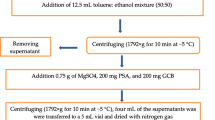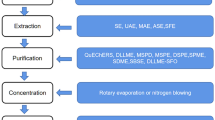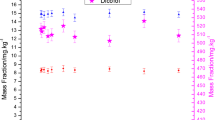Abstract
Monitoring pesticide residues is a key item in the field of food safety. Tea matrices represent a challenge in pesticide analysis due to the high content of coextracts. An interlaboratory comparison was organized to assess the performance of 73 laboratories, from 28 regions in China, on the quantification of five pesticide residues in tea matrix reference material in order to ensure the accuracy, reliability and comparability of monitored pesticide residues in foods. The tea matrix reference material spiked with pesticides was prepared according to ISO 17034. Briefly, blank green tea was spiked with bifenthrin, permethrin, fenpropathrin, buprofezin and imidacloprid, smashed, sieved, homogenized and bottled. It was assessed to be sufficiently homogeneous and stable. Participant laboratories were requested to submit quantification results with detailed analytical protocols. Assigned values were obtained from consensus values by robust analysis, and the results were assessed using z scores. The robust standard deviations for five pesticides were lower than the expected standard deviations in our interlaboratory comparison. In total, 93.8 % (255/272) of the results were acceptable (|z|≤ 2.0) and 82.2 % (60/73) of participant laboratories had satisfactory performance in pesticide residues quantification. Analytical protocols of extraction, cleanup and quantification methods were reviewed to assess their impacts on the results. Overall, a tea matrix reference material was successfully prepared for an interlaboratory comparison, and the results indicate that most of domestic laboratories have acceptable capability in pesticides quantification, while a few of them need to further optimize their protocols to improve performance.



Similar content being viewed by others
References
FDA (2020) Pesticide residue monitoring program reports and data. https://www.fda.gov/food/pesticides/pesticide-residue-monitoring-program-reports-and-data
China National Center for Food Safety Risk Assessment (2018) 2019 risk monitoring manual for national food contamination and harmful factors
ISO 13528 (2015) Statistical methods for use in proficiency testing by interlaboratory comparison. ISO, Geneva
ISO Guide 30 (2015) Reference materials—selected terms and definitions. ISO, Geneva
Zhu P, Miao H, Du J et al (2014) Organochlorine pesticides and pyrethroids in Chinese tea by screening and confirmatory detection using GC-NCI-MS and GC-MS/MS. J Agric Food Chem 62:7092–7100. https://doi.org/10.1021/jf5012424
Ren D, Sun C, Ma G et al (2018) Determination of pyrethroids in tea brew by GC-MS combined with SPME with multiwalled carbon nanotube coated fiber. Int J Anal Chem 2018:1–9. https://doi.org/10.1155/2018/8426598
Li S, Ren J, Li L et al (2020) Temporal variation analysis and risk assessment of neonicotinoid residues from tea in China. Environ Pollut 266:115119. https://doi.org/10.1016/j.envpol.2020.115119
Wang F, Li S, Feng H et al (2019) An enhanced sensitivity and cleanup strategy for the nontargeted screening and targeted determination of pesticides in tea using modified dispersive solid-phase extraction and cold-induced acetonitrile aqueous two-phase systems coupled with liquid chromat. Food Chem 275:530–538. https://doi.org/10.1016/j.foodchem.2018.09.142
Yin P, Dai J, Guo G et al (2020) Residue pattern of chlorpyrifos and its metabolite in tea from cultivation to consumption. J Sci Food Agric 101:4134–4141. https://doi.org/10.1002/jsfa.11049
Li H, Zhong Q, Wang X et al (2021) The degradation and metabolism of chlorfluazuron and flonicamid in tea: a risk assessment from tea garden to cup. Sci Total Environ 754:142070. https://doi.org/10.1016/j.scitotenv.2020.142070
Lozano A, Rajski Ł, Belmonte-Valles N et al (2012) Pesticide analysis in teas and chamomile by liquid chromatography and gas chromatography tandem mass spectrometry using a modified QuEChERS method: validation and pilot survey in real samples. J Chromatogr A 1268:109–122. https://doi.org/10.1016/j.chroma.2012.10.013
GB 2763 (2019) National food safety standard- maximum residue limits for pesticides in food. National Health Commission of the People’s Republic of China, Beijing
ISO 17034 (2016) General requirements for the competence of reference material producers. ISO, Geneva
JJF 1006 (1994) Technical norm of primary reference material. National Institute of Metrology, Beijing
JJF 1343 (2012) General and statistical principles for characterization of reference materials. General Administration of Quality Supervision Inspection and Quarantine of the People’s Republic of China, Beijing
Feng C, Xu Q, Qiu X et al (2020) Comprehensive strategy for analysis of pesticide multi-residues in food by GC–MS/MS and UPLC-Q-Orbitrap. Food Chem 320:126576. https://doi.org/10.1016/j.foodchem.2020.126576
ISO Guide 35 (2017) Reference materials-guidance for characterization and assessment of homogeneity and stability International Organization for Standardization. ISO, Geneva
GBT 28043 (2019) Statistical methods for use in proficiency testing by interlaboratory comparison. State Administration for Market Regulation and Standardization Administration, Beijing
Lu D, Qiu X, Feng C et al (2012) Simultaneous determination of 45 pesticides in fruit and vegetable using an improved QuEChERS method and on-line gel permeation chromatography-gas chromatography/mass spectrometer. J Chromatogr B 895–896:17–24. https://doi.org/10.1016/j.jchromb.2012.03.006
Thompson M, Ellison SLR, Wood R (2006) The international harmonized protocol for the proficiency testing of analytical chemistry laboratories: (IUPAC technical report). Pure Appl Chem 78:145–196. https://doi.org/10.1351/pac200678010145
Narenderan ST, Meyyanathan SN, Karri VVSR (2019) Experimental design in pesticide extraction methods: a review. Food Chem 289:384–395. https://doi.org/10.1016/j.foodchem.2019.03.045
Acknowledgements
We thank the 73 laboratories for their participation in the interlaboratory comparison.
Funding
This work was supported by the National Key R&D Program of China [Grant Numbers 2017YFC1601300].
Author information
Authors and Affiliations
Contributions
YC contributed to conceptualization, investigation, formal analysis, writing—original draft. XQ contributed to conceptualization, investigation, formal analysis, writing—original draft. CF contributed to methodology, formal analysis, writing—review and editing. QX contributed to investigation, writing—review and editing. YL contributed to formal analysis, writing—review and editing. SL contributed to formal analysis, writing—review and editing. YJ contributed to methodology, writing—review and editing. GW contributed to resources, supervision, writing—review and editing. DL contributed to resources, conceptualization, investigation, writing—review and editing.
Corresponding author
Ethics declarations
Conflict of interest
We declare no competing interests.
Additional information
Publisher's Note
Springer Nature remains neutral with regard to jurisdictional claims in published maps and institutional affiliations.
Supplementary Information
Below is the link to the electronic supplementary material.
Rights and permissions
About this article
Cite this article
Chen, Y., Qiu, X., Feng, C. et al. Preparation of a reference material for tea containing five pesticide residues and its evaluation in an interlaboratory comparison study in China. Accred Qual Assur 27, 93–101 (2022). https://doi.org/10.1007/s00769-022-01494-y
Received:
Accepted:
Published:
Issue Date:
DOI: https://doi.org/10.1007/s00769-022-01494-y




